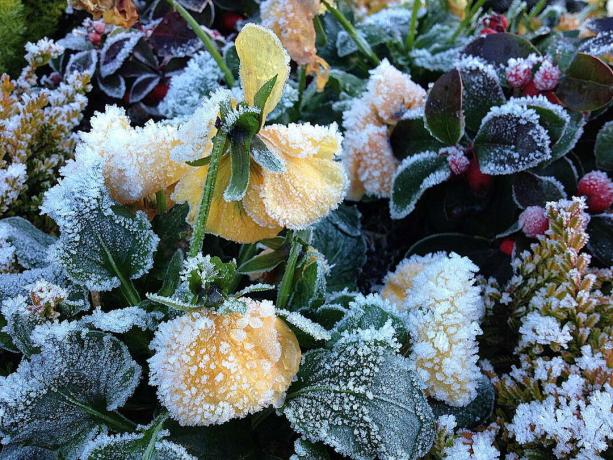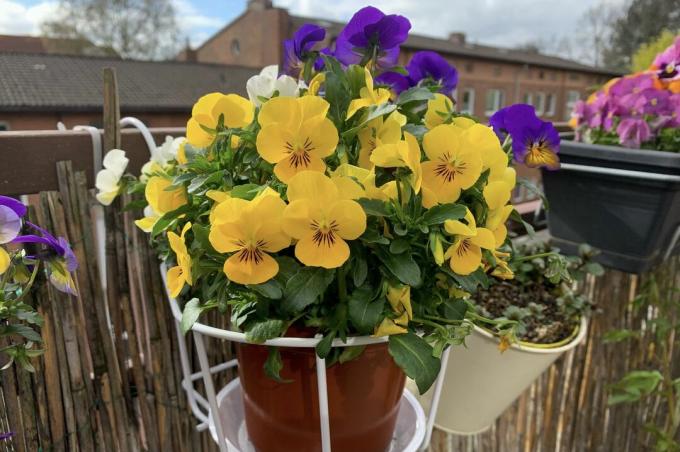Horned violets let the old year end in bloom and ring in the new one as well. But do horned violets have to be protected from frost?

horned violet (Viola cornuta) belong to the genus of violets (viola). Horned violets live up to their botanical name with their violet or lilac colored petals. The numerous ornamental varieties offer an even greater range of colors, ranging from yellow to blue to red, white and almost black tones. There are also varieties with color gradients or drawings. But horned violets not only impress with their color spectrum, but also with their long flowering period and durability, which allows them to withstand decent minus temperatures.
contents
- Flowering time of horned violets
-
Horned violets in frost: when and how to protect?
- Protect horned violets from frost in the bed
- Protect horned violets from frost in pots and tubs
Flowering time of horned violets
Depending on the variety, horned violets bloom from April to October. There are varieties such as 'Molly Sanderson' and 'Alba Mino', which continuously present their flowers. However, most varieties bloom in spring from April to June. With the right care, you can get your plants to bloom a second time. As a basis for an autumn blossom, two things must be fulfilled:
- A healthy plant
- Cut back after flowering

When pruning the plants after spring flowering, the plant is cut back by about half. This not only promotes flowering in autumn, but also bushy growth. Cleaning out wilted flowers also extends the flowering period.
Horned violets in frost: when and how to protect?
Horned violets are biennial to short-lived plants. In the Pyrenees, the wild varieties can still be admired at an altitude of 2500 meters. In order to be able to withstand the cold winter winds of their homeland, horned violets must be able to withstand a few sub-zero temperatures. Accordingly, some varieties do not even mind temperatures of down to -15 °C. Most strains tolerate temperatures as low as -5°C with ease. This is made possible by the glycerin in the cells, which protects the plants from freezing. Only the flowering stays out in the icy environment. There are particularly robust varieties such as the 'Ice Babies' series. But even the most robust variety can get through the winter better with a little help and can start the new flowering phase optimally strengthened.

notice: If the horned violets do not survive the winter, this is not always due to a lack of winter hardiness of the plants. Other reasons are:
- frost
- permanent wetness
- decrepitude
Protect horned violets from frost in the bed
In order to get your horned violets planted out in the bed well over the winter, proceed as follows:
- October: Cut back to just above ground level
- Cover plants with: fir branches, fleece, brushwood, leaves, moss, bark mulch or spruce branches
- Neither water nor fertilize
- Late February/early March: Removal of winter protection
The protective layer protects the plants from the sub-zero temperatures of winter and allows them to take a relaxing break until the next flowering phase. The cover also protects against drying out in the spring. If the plants sprout too early, the root balls are still frozen and the plants die of thirst (bare frost).
These products protect your plants from frost:- Thermal garden fleece: Optimal to protect your plants from cold and frost in winter. Can be cut individually.
- Jute sack/blanket: Reliable protection against cold and frost made from 100% jute. Decorative natural fabric with a long service life.
- coconut mat: Excellent thermal retention made of natural fiber. Breathable, weather-resistant and durable.

Garden fleece, frost protection, growth-promoting microclimate
4,49€
Details →

Jute protective fleece made of 100% jute fibers, approx. 105x500cm
11,03€11,01€
Details →
- 30%

Coconut felt mat, cold protection 0.5 x 1.5 m, brown,
9,99€6,95€
Details →
Protect horned violets from frost in pots and tubs
Horn violets in pots or tubs can be overwintered in the garage or in the basement. If the pots are to remain outside, a sheltered spot must be chosen. To prevent the soil in the pot from freezing, wrap the pot in fleece or newspaper. As in the bed, the plants are cut back and covered with a protective layer. Fleece is best for potted plants. If your horned violets are covered, they must be watered lightly even in winter. However, fertilizing is unnecessary. Here, too, the winter protection is removed at the end of February/beginning of March.

In addition to antifreeze, there is a lot to do with the Planting and caring for horned violets to note. You can find out exactly what in our dedicated article.
